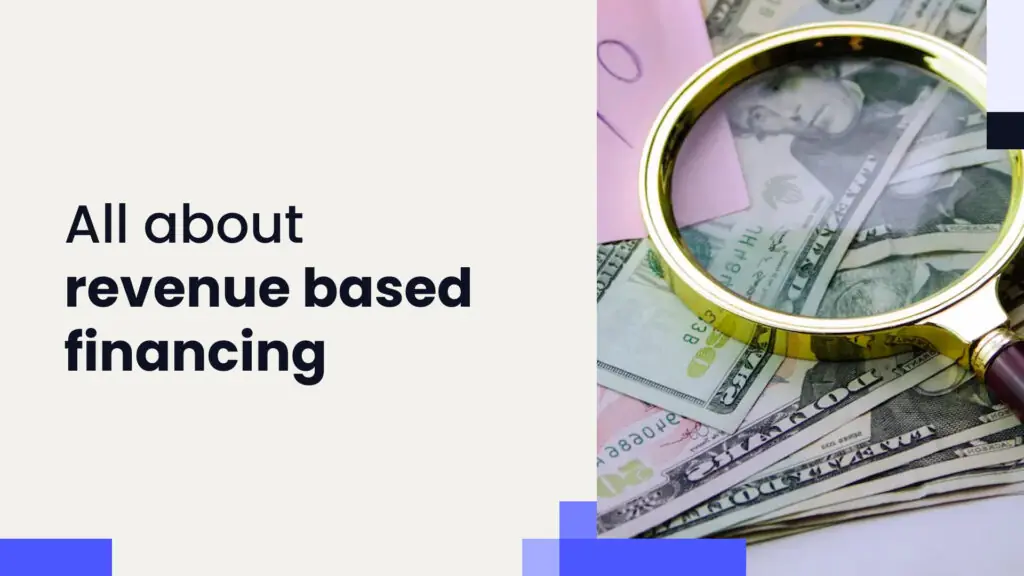- What is revenue based financing?
- Factor rates and revenue based financing
- Types of revenue based financing repayment plans
- Businesses that can benefit from revenue based financing
- The pros of revenue based financing
- The cons of revenue based financing
- Can you use revenue based financing as debt consolidation?
- How to apply for revenue based financing
- Legalities of revenue based financing
- A unique alternative to revenue based financing for eCommerce
When it comes to funding your business, you have an overwhelming number of eCommerce financing solutions at your disposal. Choosing the right one is important if you want to grow your business without going into debt. Revenue based financing is a great choice for many businesses.
Revenue based financing is a form of funding that you repay as a percentage of your monthly revenue. Read on to learn more about revenue based financing, the pros and cons of this funding solution, and how it may benefit your business.
What is revenue based financing?
Revenue based financing, or RBF, is a funding option that allows you to borrow capital up front and make repayments based on your revenue. Instead of regular, set payments, your repayments are calculated as a percentage of your revenue.
The idea is that you never pay back more than you make in revenue, allowing you to avoid overdrawing on your accounts to help make payments. Instead of set monthly payments, the revenue based financing company will take a percentage of your incoming revenue as their payment until the balance is repaid.
For example: You borrow $100,000 in capital at a revenue based share of 5%. This means the financier will take 5% of your revenue each month.
In month 1, you bring in $20,000 in revenue. 5% of $20,000 is $1,000, so your payment this month is $1,000 (20,000 x 0.05 = 1000).
In month 2, you bring in $50,000 in revenue, making your payment $2,500 because 5% of $50,000 is $2,500.
Now in month 3, you find it’s a slower season, items are out of stock, or there are other reasons you haven’t been able to make sales as high as previous months. Revenue for this month is only $10,000. Since your payment amount is 5% of your revenue, the good news is that your repayment this month is only $500, which is significantly lower than your previous payments.
But let’s say the next month you invested in advertising and marketing or your inventory finally came in, and you earned $75,000 in revenue. You are back on track with a payment of $3,750.
Subscribe to the eCommerce newsletter for
top industry insights
See how that works? You never pay more than you earn. The flexible repayment option allows you to avoid fixed and rigid schedules. Instead, you continue making payments until your loan is settled.
Factor rates and revenue based financing
We have talked about making repayments based on a percentage of your gross revenue, but how do you consider fees, interest, and the overall costs of revenue based financing? Money is never free, so you are probably already considering what this financing venture will cost you in the long run.
If we think about it, paying a percentage of your revenue every month could end up being a very long endeavor. With traditional loans, the interest is calculated into a fixed payment. Instead of interest rates, revenue based financing utilizes factor rates to determine the end cost of the loan.
Factor rates are a multiple of the loan that accounts for the total cost, fees, and regular repayments. These rates usually run from 1.1 to 1.9 times the loan amount, but can be as expensive as 2-2.5 times the principal.
So let’s look at the example we discussed in the previous section where you borrowed $100,000. At a factor rate of 1.5, your loan will be settled once you have paid a total of $150,000 to the lender (100,000 x 1.5 = 150,000).
The benefit of a factor rate is that you do not accrue or compound interest based on the time it takes to pay off the loan. The final cost is just that: final. Using factor rates is a type of repayment ceiling and you won’t have to pay more than this amount. Your ending amount does not change based on your payment amount.
Types of revenue based financing repayment plans
Before you sign an agreement with a revenue based financing company, it’s a good idea to know exactly what kind of RBF you are getting into. Revenue based financing agreements are categorized into three deadlines: when the factor rate is reached, when an end-date is reached, or when the rate of return is reached.
Each of these requires the principal amount to be repaid with interest, but based on different deadlines. Let’s take a look at how each deadline affects your repayment schedule.
Factor rate is reached
The original example we described in the above sections uses a factor rate to determine the end costs for the revenue based financing agreement. Once this total amount is reached, you are free from the loan and are no longer required to make further payments.
Using factor rates to determine the end of the loan is the most common contract used with revenue share agreements. Additionally, it is the most flexible because it is based on a dollar amount rather than a time frame to pay off the balance. We will expand more on this point in the next section (end date is reached).
Keep in mind that a factor rate based revenue share agreement allows you to make payments over a longer period of time with minimal to no surprises regarding the end cost.
End date is reached
Revenue based financing agreements are based heavily on your revenue history, so your investors and lenders may set an expected end date where they collect a percentage of your monthly revenue for the predetermined period of time.
Of course, you are still required to pay back your principal investment. This type of agreement could look like this:
You have a certain amount of time to repay the initial investment plus a factor rate. If this amount is not reached on time, costs and fees could incur.
A certain amount of time is set after the initial investment is repaid where you will continue to remit a portion of your revenue to the lender. However much they collect is their “interest” for the investment.
Once the end date is reached and the initial investment is paid plus the cost of capital, your contract is settled. However, end date based RBF agreements are less common than factor rate agreements because the amount of return is uncertain and not guaranteed. If you have several months of low revenue, the lender makes less money during that period of time. It is a greater risk with lower reward for the investor.
Businesses that can benefit from revenue based financing
We all know that one-size-fits-all financing does not exist. So how do you decide if revenue based finance is right for you? Well, let’s take a look at some of the problems you might face in your business that could be solved with flexible capital.
If your business falls into one of the following categories, revenue based financing might be a good fit for you.
Seasonal uptick
For businesses that have a heavy busy season (think winter holidays, especially around November and December), having a little extra cash flow could be the difference between keeping up with demand and facing a stockout. Stockouts mean no revenue and can even impact your business’s rank and reputation. You don’t want to wind up in that situation. When you are forecasting an increase in demand, securing extra cash quickly is a necessity.
eCommerce businesses
Whether you are procuring new inventory or experimenting with higher volume, you need money to finance your goals. eCommerce businesses are rife with change including customer demand, supply availability, supply chain delays or disruption, and more. You need the ability to make changes on the go. Increasing your cash flow to accommodate these unexpected occurrences not only helps you break even but allows you to overcome the hurdles and keep making a profit.
Popular content
- 14 strategies to improve your eCommerce business’s financial health
- 50+ ChatGPT prompts to elevate your eCommerce business
- A guide to pricing your product on Amazon
- 5 marketing metrics all eCommerce businesses should track
- All about Amazon PPC
Subscriptions and predictable revenue streams
Businesses that operate on a subscription based service are ideal candidates for revenue based financing. Your subscriptions are guaranteed revenue that the lender will consider when deciding your loan amount. This makes you a less risky investment for the lender and guarantees you can make repayments without stressing as much about those low revenue months.
Might also interest you:
- eCommerce financing: how to fund your online business
- Growth financing: everything you need to know
- 6 questions to ask yourself before choosing eCommerce financing
The pros of revenue based financing
Now that we are well versed in the whats and hows that are involved in revenue based financing, it’s time to discuss the benefits. Remember, benefits of any financial option are generalized and may not fit your needs or accommodate your business exactly the same as other businesses. It is also important to remember some of the points we discuss may not directly be a benefit for you and your business, but more of a bonus.
The pros of revenue based financing include:
- Fast funding: Nothing is worse than applying for a loan and waiting days or weeks for funding. After approval, you can see your funds in your account as soon as the next business day with many revenue based lenders. Next business day funding makes the difference when you are ready to jump on that additional inventory or start that new project on time as opposed to waiting weeks to get things rolling. When you have a solid business plan, you have to account for hiccups, but with revenue based financing, you can keep your projects and products moving without long delays.
- Use the funding as you see fit: Some types of financing require you to follow specific guidelines regarding how you use your money. For example, with inventory financing you are only allowed to use the loan to procure or manufacture inventory. With revenue based financing, you are in control of how the funding is spent – meaning you have the authority to spend the money wherever your business will benefit. So hire that warehouse worker, finance the new office space, or procure that seasonal stock to scale your business to the next level.
- Keep control of your business: Not only do you have full control of how you spend the money, you keep control of your business. Other financing agreements, such as venture capital and angel investor agreements may take equity in your company – including partial or final say in how you run your business. Not only does that create potential conflict with your business goals, but you can’t jump on that next project without consulting your new financial partner first.
- No personal guarantee: We can think of a million things we’d rather do than risk our personal assets and financial security if we were to default on a loan. Many financial options, including bank loans, may require you to put forth business or personal assets to cover the loan if you don’t pay it back. That puts you in jeopardy of losing your home, vehicles, and investments. Skip that nonsense by choosing a financial partner that works with you instead of against you. Revenue based financing focuses on your revenue history to determine if you can repay the loan, not the value of your personal or business assets.
- Credit checks not required: Another big bonus for many businesses is the fact that revenue based financing is not based on credit. As we’ve said before, revenue based financing focuses on your past revenue and your projected revenue to ensure you can repay the loan. This is great news for businesses that are still building their credit and can’t qualify for more traditional loans. Having minimal credit or bad credit does not necessarily hinder you in your financial endeavors when it comes to revenue based financing.
- Variable repayment terms: Traditional bank loans are not going to afford you the flexibility that RBF can give you. When you set up a bank loan, you have fixed payments and a scheduled amount of months to pay it off. With RBF, those terms are customizable. You can work with your RBF lender to negotiate terms, rates, and time limits. You never pay back more than you earn, allowing you to continue to improve cash flow and avoid overdraft fees and late payments.
- Total costs up front: With traditional bank loans, your end balance changes based on interest and length of payments. Regardless of which method your lender chooses, RBF lays out the final costs (and repayment terms) ahead of time so you always know what your final dollar amount will be.
- Works with other financing options: Using a revenue based financing solution, you can kickstart your lending history, making you a more reliable borrower later on. Your RBF lender may or may not report to a credit bureau, so you should find out if that could impact your credit score in a positive or negative direction. However, utilizing revenue share agreements to improve your cash flow allows you to show that you are increasing your revenue and help you get approved for other types of financing.
The cons of revenue based financing
With every benefit there is a downside. In order to make a well informed decision about whether revenue based financing is right for your business, you have to be able to weigh the pros and cons. Looking at RBF from all sides allows you to not only determine if it is the right option, but informs you of what to be aware of in the long haul. Let’s take a look at the main drawbacks of revenue based financing.
The cons of revenue based financing include:
- Can be more expensive than other options: We aren’t saying that revenue based financing is the most expensive option out there, but compared to bank loan interest rates, it can fall on the more expensive side. In addition, you cannot pay off your balance early which would save you some money in the long run.
- Cannot pay off early: Sure, you can technically pay off your balance early if you have the cash to do so, but the point we are making here is that there is no incentive. When you are dealing with factor rates, there is no way to pay off the loan early to save money on interest and fees. The predetermined amount is what you owe regardless of how long it takes you to pay it off. In reality, you actually have a lower APR if you don’t pay off the loan early.
- Smaller amounts of capital: For certain businesses, other financial streams could offer you a larger lump sum depending on the institution. RBF lenders tend to cap the funding amount based on a business’s monthly revenue. In these cases, traditional banks or venture capitalists may be able to offer higher amounts up front than you would receive with revenue based financing. However, each of those options comes with its own downsides. Utilizing venture capitalist resources can dilute your equity and control of your company. Traditional bank loans are rigid with a fixed monthly payment.
- Must produce revenue to qualify: This one sounds like a no-brainer after all we’ve discussed so far, but it’s important to remember. Your business has to produce revenue in order to qualify for revenue based financing. In order for the lender to take a portion of your business income, you have to generate an income. Whether this is through product sales, subscription services, or other avenues, you need to be able to show a monthly stream of money flowing into your business.
Can you use revenue based financing as debt consolidation?
You can use revenue based financing to consolidate your debt. Since you have full control over how the money is being used, you can pay off other loans or credit lines using your funding. The repayment process is the same and you can make repayments based on your revenue.
Using revenue based finance as debt consolidation allows you to repay the debt without incurring compound interest and fees. You are also guaranteed the peace of mind that you are never making payments above the amount of your revenue.
How to apply for revenue based financing
The process to apply for a revenue based financing agreement is simple once you have found a lender. You will be required to provide your business name, address, and phone number. Sometimes you will be asked to provide your EIN or Tax ID.
In order to qualify, you will need to provide some details about your business. This includes your monthly revenue over a specified period of time, usually 6-12 months. Once you are approved, you will receive an offer. If you choose to accept the offer, your funds will be made available to you within a specified period of time.
Legalities of revenue based financing
Currently in the United States, only four out of 50 states (Virginia, New York, California, and Utah) have initiated regulations for revenue based financing agreements. The problem is that there is a difference between a loan and a revenue sale. Revenue based financing falls somewhere between these two lines, and each state has to determine whether it is a commercial transaction (revenue sale) or a loan.
This leaves room for predatory lenders to take advantage of the system. Most revenue share agreements are 100% legit and borrowers do not face any issues with their lenders. However, should you find yourself a victim of these unsavory mongers that slip through the cracks, each state has their own Unfair and Deceptive Acts and Practices (UDAP) and Racketeer Influenced and Corrupt Organization Act (RICO) laws to help you.
A unique alternative to revenue based financing for eCommerce
If you own an eCommerce business and are looking for a unique solution to help you grow your business, 8fig can help.
8fig is different in that it offers eCommerce sellers a cash flow management solution in addition to flexible, continuous funding. This ensures that businesses have the resources they need to grow when they need them most.
In fact, 8fig can fund up to 90% of your supply chain costs.
So, how can 8fig help your business grow up to 4X times as fast? Sign up for a Growth Plan today and find out!
Have article ideas, requests, or collaboration proposals? Reach out to us at editor@8fig.co – we’d love to hear from you.
- 9 powerful legal ways to protect your eCommerce products from copycats
- The hidden cost of stockouts: A data-driven analysis showing how missing inventory impacts your eCommerce revenue
- 100 questions for eCommerce sellers to ask ChatGPT
- How to write product titles and descriptions that convert
- Holiday rush readiness: top 8 tips for handling seasonal demand peaks
Subscribe to the eCommerce newsletter for
top industry insights
to our blog
Read the latest
from 8fig

Video ads can make or break your eCommerce success. Learn five essential strategies to create high-converting campaigns that captivate and convert.

Crack the code to funding your eCommerce business with this step-by-step guide, and learn how to secure the capital you need to grow while staying on top of your strategy.

From managing cash flow to optimizing expenses, this guide offers actionable insights to secure your financial future. Explore the essential steps to drive profitability and long-term success.
